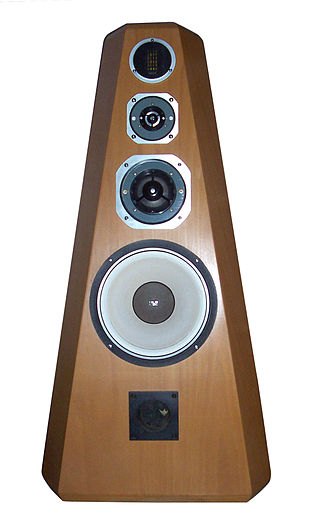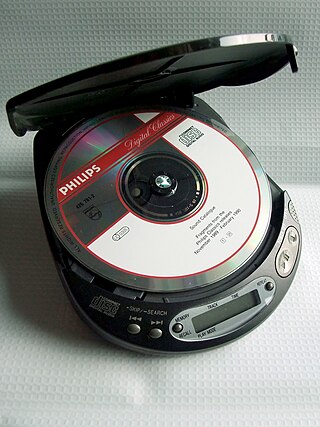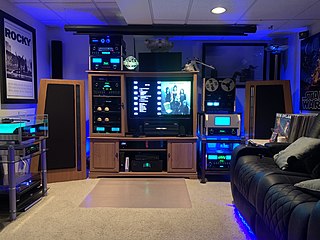
The compact disc (CD) is a digital optical disc data storage format that was co-developed by Philips and Sony to store and play digital audio recordings. It uses the Compact Disc Digital Audio format which typically provides 74 minutes of audio on a disc. In later years, the compact disc was adapted for non-audio computer data storage purposes as CD-ROM and its derivatives. First released in Japan in October 1982, the CD was the second optical disc technology to be invented, after the much larger LaserDisc (LD). By 2007, 200 billion CDs had been sold worldwide.

CD-R is a digital optical disc storage format. A CD-R disc is a compact disc that can only be written once and read arbitrarily many times.

High fidelity is the high-quality reproduction of sound. It is popular with audiophiles and home audio enthusiasts. Ideally, high-fidelity equipment has inaudible noise and distortion, and a flat frequency response within the human hearing range.

An optical disc is a flat, usually disc-shaped object that stores information in the form of physical variations on its surface that can be read with the aid of a beam of light. Optical discs can be reflective, where the light source and detector are on the same side of the disc, or transmissive, where light shines through the disc to be detected on the other side.

Compact Disc Digital Audio, also known as Digital Audio Compact Disc or simply as Audio CD, is the standard format for audio compact discs. The standard is defined in the Red Book technical specifications, which is why the format is also dubbed "Redbook audio" in some contexts. CDDA utilizes pulse-code modulation (PCM) and uses a 44,100 Hz sampling frequency and 16-bit resolution, and was originally specified to store up to 74 minutes of stereo audio per disc.

Super Audio CD (SACD) is an optical disc format for audio storage introduced in 1999. It was developed jointly by Sony and Philips Electronics and intended to be the successor to the compact disc (CD) format.

An audiophile is a person who is enthusiastic about high-fidelity sound reproduction. The audiophile seeks to achieve high sound quality in the audio reproduction of recorded music, typically in a quiet listening space in a room with good acoustics.

A CD player is an electronic device that plays audio compact discs, which are a digital optical disc data storage format. CD players were first sold to consumers in 1982. CDs typically contain recordings of audio material such as music or audiobooks. CD players may be part of home stereo systems, car audio systems, personal computers, or portable CD players such as CD boomboxes. Most CD players produce an output signal via a headphone jack or RCA jacks. To use a CD player in a home stereo system, the user connects an RCA cable from the RCA jacks to a hi-fi and loudspeakers for listening to music. To listen to music using a CD player with a headphone output jack, the user plugs headphones or earphones into the headphone jack.

The Rainbow Books are a collection of CD format specifications, generally written and published by the companies involved in their development, including Philips, Sony, Matsushita and JVC, among others.
High Definition Compatible Digital (HDCD) is a proprietary audio encode-decode process that claims to provide increased dynamic range over that of standard Compact Disc Digital Audio, while retaining backward compatibility with existing compact disc players.

Mobile Fidelity Sound Lab is a record label that specialized in the production of audiophile issues. The company produces reissued vinyl LP records, compact discs, and Super Audio CDs and other formats.

The SPARS code is a three-position alphabetic classification system developed in the early 1980s by the Society of Professional Audio Recording Services (SPARS) for commercial compact disc releases to denote aspects of the sound recording and reproduction process, distinguishing between the use of analog equipment and digital equipment. The code's three positions refer to recording, mixing, and mastering respectively. The first two positions may be coded either "A" for analog or "D" for digital; the third position (mastering) is always "D" on digital CDs. The scheme was not originally intended to be limited to use on digital packaged media: it was also available for use in conjunction with analog releases such as vinyl or cassette, but this was seldom done in practice.

CD Video was a format of optical media disc that was introduced in 1987 that combines the technologies of standard compact disc and LaserDisc. CD-V discs are the same size as a standard 12 cm (4.7 in) audio CD, and contain up to 20 minutes' worth of CD audio that can be played on any audio CD player. It also contains up to 5 minutes of LaserDisc video information with digital CD-quality sound, which can be played back on a newer LaserDisc player capable of playing CD-V discs or CD-V-only players.
Disc rot is the tendency of CD, DVD, or other optical discs to become unreadable because of chemical deterioration. The causes include oxidation of the reflective layer, reactions with contaminants, ultra-violet light damage, and de-bonding of the adhesive used to adhere the layers of the disc together.

CD-RW is a digital optical disc storage format introduced by Ricoh in 1997. A CD-RW compact disc (CD-RWs) can be written, read, erased, and re-written.

A CD-ROM is a type of read-only memory consisting of a pre-pressed optical compact disc that contains data computers can read, but not write or erase. Some CDs, called enhanced CDs, hold both computer data and audio with the latter capable of being played on a CD player, while data is only usable on a computer.

Home audio refer to audio consumer electronics designed for home entertainment, such as integrated systems like shelf stereos, as well as individual components like loudspeakers and surround sound receivers.
Marshall Blonstein is an entertainment industry executive who is best known as the founder and president of the audiophile music labels Audio Fidelity and DCC Compact Classics. He also held positions at labels including Island and Ode.
The Warner Premium Sound series is series of 2011 hybrid multichannel-stereo Super Audio CD/CD releases, which an important development in the format war between Super Audio CDs (SACDs) and DVD-Audio discs. It marks the first time that the Warner Music Group has released titles in the SACD format; previously they had endorsed the DVD-Audio format. In a parallel development in the United States, four albums by the Doors, titles strongly associated with the Warner Music Group, are also to be released on hybrid multichannel-stereo SACDs by Analogue Productions. Also Mobile Fidelity have been issuing and continue to be issuing SACDs of the Warner catalogue, but in the past these have been stereo-only discs, and for their new releases they do not specify whether a given disc might have multichannel contents also.
High-resolution audio is a term for audio files with greater than 44.1 kHz sample rate or higher than 16-bit audio bit depth. It commonly refers to 96 or 192 kHz sample rates. However, 44.1 kHz/24-bit, 48 kHz/24-bit and 88.2 kHz/24-bit recordings also exist that are labeled HD audio.














